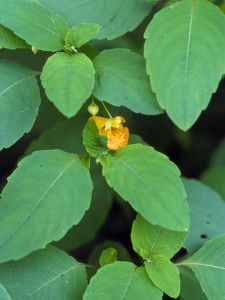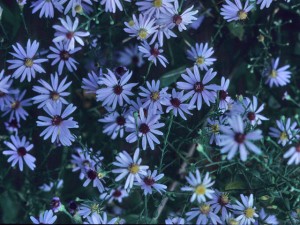
Maidenhair fern retains its graceful beauty well into fall. © Photo Michael A. Homoya
For those of us who trek woodlands in search of flora, Michael Homoya has written the perfect book companion.
Wildflowers and Ferns of Indiana Forests (Indiana University Press, 2012, paperback, $22.95) covers nearly 300 native  species, their attributes, habitats and snippets of natural history.
species, their attributes, habitats and snippets of natural history.
“I’ve traveled around our country a bit, even to other continents, but nowhere have I seen anything to compare to the springtime in our state’s forests,” Homoya wrote in the field guide’s introduction.
The Illinois native is a botanist and plant ecologist who has been with the Indiana Department of Natural Resource’s Division of Nature Preserves since 1982. All of the book’s royalties will go to the DNR Heritage Trust for land acquisition. Homoya also is the author of Orchids of Indiana, published in 1993 by IU Press.
Just like his orchid book, which revealed that Indiana has 42 native orchids compared to three species that call Hawaii home, Homoya’s new offering is full of surprises, just like the state’s landscape.
“Throughout the growing season, there are plants of almost every size, shape and color. Look and you will see,” he wrote.
Homoya tired to hedge a bit when asked to name some fall favorites.

Jewelweed. Photo courtesy wildflower.org
“There are so many favorites,” he said, finally naming jewelweed or the spotted touch-me-not (Impatiens capensis), Short’s aster (Aster shortii) and maidenhair fern (Adiantum pedatum).

Short's aster. Photo courtesy wildflower.org
“Short’s aster, named after the great Kentucky pioneer botanist Charles Short, is a stunningly attractive aster. The touch-me-not is a fun plant in many ways, especially setting off the exploding seed pods. And maidenhair fern is grace epitomized,” he said.
Homoya will be one of the speakers at the Indiana Native Plant and Wildflower Society’s annual conference Nov. 3 (www.inpaws.org) at the University of Indianapolis. He also will speak at 7:30 p.m., Nov. 15 at the Indianapolis Museum of Art. Sponsored by the IMA Horticultural Society, Homoya’s talk is free in The Toby.